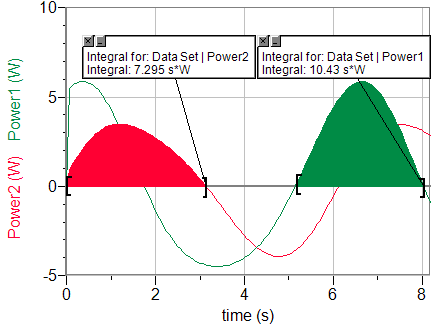Leg lift
Wednesday 1 August 2012
 Ever since I went on that treadmill in Kazakhstan I've been thinking about the mechanics of running up a hill when you're not running up one. The reason it's more difficult to run on an inclined treadmill is not because you're running up a hill but because each leg has to be lifted each step. I tried to make an IP animation to show this and came up with the leg lifter. The power behind the leglifter is a motor that turns at a constant rate. The power of this motor gives an idea of the work being done, it's the area under the Power - time graph shown. The data from interactive physics can be exported to LoggerPro (via notepad) to make the analysis easier. The area under the graph for one cycle is zero this is because there is no friction, however if we consider the work done in pushing the leg forward (the positive part of the curve) then we see it's bigger in the inclined case than in the flat case (confusingly power 2 is the flat one and power 1 the incline). So work done is significantly bigger when running up an inclined treadmill than a flat one. Once again physics proves something that we already knew.
Ever since I went on that treadmill in Kazakhstan I've been thinking about the mechanics of running up a hill when you're not running up one. The reason it's more difficult to run on an inclined treadmill is not because you're running up a hill but because each leg has to be lifted each step. I tried to make an IP animation to show this and came up with the leg lifter. The power behind the leglifter is a motor that turns at a constant rate. The power of this motor gives an idea of the work being done, it's the area under the Power - time graph shown. The data from interactive physics can be exported to LoggerPro (via notepad) to make the analysis easier. The area under the graph for one cycle is zero this is because there is no friction, however if we consider the work done in pushing the leg forward (the positive part of the curve) then we see it's bigger in the inclined case than in the flat case (confusingly power 2 is the flat one and power 1 the incline). So work done is significantly bigger when running up an inclined treadmill than a flat one. Once again physics proves something that we already knew.


